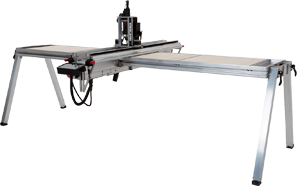Console operations - Starting a job from PRO
Home » Knowledge Base » SmartBench Knowledge Base » Console operations » Starting a job from PRO
Quick commands
A: Exit the PRO App to the console menu.
B: Home SmartBench. Click here to learn more about homing.
C: Reset SmartBench. This is used to clear alarm states.
D: Starting a job. See below sections to learn more about this.
E: Stop SmartBench if it is in motion.
Status bar
A: Machine connection.
B: Wifi Connection.
C: IP Address – you will see this if you are connected to wifi.
D: SmartBench’s position on the X axis with respect to SmartBench home.
E: SmartBench’s position on the Y axis with respect to SmartBench home.
F: SmartBench’s position on the Z axis with respect to SmartBench home.
G: SmartBench’s position on the X axis with respect to the work datum.
H: SmartBench’s position on the Y axis with respect to the work datum.
I: SmartBench’s position on the Z axis with respect to the work datum.
J: SmartBench status (e.g., Idle, Run, Home).
Side tabs
A: File load and preview tab
B: Virtual SmartBench tab
C: Manual Move
D: Gcode Monitor
File load and preview
A: Press to load a file. Click here to learn more about file transfer.
B: Your file will be previewed in this space. You can touch the preview to zoom in and out, or move the preview around this part of the screen.
Virtual SmartBench
A: Job area.
B: Set Park position
C: Set datum. Click here to learn more.
D: Go to Park position.
E: Go to datum.
Manual move
A: Move and datum set controls for the X-Y axis.
B: Speed toggle (high/low).
C: Extraction toggle (on/off).
D: Spindle toggle (on/off).
E: Move and datum set controls for the Z axis.
GCode monitor
A: Text input to send GCode commands directly to the machine.
B: GCode monitor display.
C: Real time status monitor.
D: Show/Hide “ok”s after sending GCode commands.
E: Show GCode dollar settings.
F: Show GCode parameters.
G: Show GCode state.
H: Show build version information (Firmware and Hardware versions).
I: Put SmartBench into Check mode.
J: GCode Help
K: Clear GCode monitor.
In the console menu, click on the “Pro” App.
Press the folder button in the top left of the console screen.
Press on a file icon, either in the local file chooser or the USB stick file chooser.
If you want to learn more about how to transfer a file onto your console via wifi or USB, click here.
If you want to see a list of your files, you can press the list/thumbnail toggle button in the bottom left of the screen.
When you have selected the file you want to run, press the tick button in the bottom right of the screen.
The console will start to read in your file.
When your file has finished loading, it will say “Job loaded” at the top of the screen.
It is recommended that you check your file for errors before running it if it is a file you have not run on SmartBench before. This will catch any errors that would otherwise stop your job at runtime.
Press “Yes” to check your job.
Depending on the size of your job, it may take a few minutes to check your file.
When the file has been checked, the screen will tell you if the file passed, and what to do next.
If your job is OK, press the “Finish” button to finish loading the file.
If your job contains errors, press “Finish” to unload it. Check the file on your computer before trying to load it again.
In the console menu, click on the “Pro” App.
Before you manually move your machine, it is best to Home it first.
Click here to learn more about homing SmartBench.
When your machine has been homed, click on the Manual Move tab on the left hand side of the console screen.
The four arrows on the left hand side of the console screen control how SmartBench moves along the X-Y axes.
The two arrows on the right hand side of the console screen controls how SmartBench moves along the Z axis.
The tortoise/hare toggle changes how quickly SmartBench moves. When the tortoise is showing, SmartBench will move slowly.
When the hare is showing, SmartBench will move quickly.
The button in the centre of the X-Y arrows changes the distance of each move, each time you press it.
The infinity sign means that SmartBench will move while you are holding down any of the arrow buttons.
The box icon means that SmartBench will trace around your loaded job.
10 mm means that SmartBench will travel 10 mm every time you press one of the arrow buttons.
1 mm means that SmartBench will travel 1 mm every time you press one of the arrow buttons.
0.1 mm means that SmartBench will travel 0.1 mm every time you press one of the arrow buttons.
0.01 mm means that SmartBench will travel 0.01 mm every time you press one of the arrow buttons.
In the console menu, click on the “Pro” App.
Your machine must be homed before you set any datums. If it is not homed already, Home SmartBench now.
Click on the Manual Move tab on the left hand side of the console screen.
Setting the datum in the X and Y axes at the same time
Using the manual move arrows, move SmartBench to your desired datum position.
If you are using the tool as your reference point (as opposed to the laser crosshair), you may want to lower the tool using the Z axis controls.
When you are happy, press the SET datum button in the bottom middle of the console screen.
Or, press the position tab, and set the datum using the SET datum button in the bottom left of the console screen.
Press Yes to confirm your choice.
If you have the laser datum enabled, check the “Use laser datum?” checkbox to use the laser to set the datum, and press “Yes”.
If you have the laser datum enabled, but would prefer not to use the laser on this occasion, uncheck the checkbox and press “Yes”.
Setting the datum in only the X axis
On the position screen, select the “SET X” button.
If you do not have the laser datum enabled, press “Yes”.
If you have the laser datum enabled, check the “Use laser datum?” checkbox to use the laser to set the datum, and press “Yes”.
If you have the laser datum enabled, but would prefer not to use the laser on this occasion, uncheck the checkbox and press “Yes”.
Setting the datum in only the Y axis
On the position screen, select the “SET Y” button.
If you do not have the laser datum enabled, press “Yes”.
If you have the laser datum enabled, check the “Use laser datum?” checkbox to use the laser to set the datum, and press “Yes”.
If you have the laser datum enabled, but would prefer not to use the laser on this occasion, uncheck the checkbox and press “Yes”.
Click here to learn more about what a datum is.
In the console menu, click on the “Pro” App.
Your machine must be homed before you set any datums. If it is not homed already, Home SmartBench now.
Click here to learn more about homing SmartBench.
Click on the Manual Move tab on the left hand side of the console screen.
If your material is uneven, and you need to set the Z datum at a specific point on the surface (e.g. the highest point), you may want to manually move SmartBench to a certain position along the X and Y axes first.
Read the above section to learn more about manual moves.
You do not need to set the Z datum in the same position that you set the X-Y datum.
You can set the Z datum manually, or SmartBench can automatically detect the material surface using the Z probe plate.
Click here to learn how to manually set the datum.
Click here to learn how to set the datum using the Z probe plate.
Manually setting the Z datum
Using the manual move buttons, move SmartBench in the Z axis to your desired datum position.
Read above section to learn more about manual moves.
Press the SET datum button on the bottom right of the console screen to set the Z datum.
When you have set the datum, you will see the red and yellow cut zone move to where the tool is in the virtual tool graphic.
The yellow box represents the tool retract height, and the red box represents the depth of cut.
Setting the Z datum using the Z probe plate
SmartBench can automatically detect the material surface using the Z probe plate, and set the Z datum accordingly.
Before using the probe plate, you may want to toggle the speed to high and use the manual move buttons to move SmartBench along the Z axis, closer to the material surface.
Read above to learn more about manual moves.
Remove the Z probe plate from the back of the Z head, and place it underneath the tool tip.
Press the Z Probe button on the right hand side of the console screen.
SmartBench will automatically detect when the tooltip has touched the Z probe plate, and set the datum.
When the datum has been set successfully, you will see the red and yellow cut zone move to where the tool is in the virtual tool graphic once the datum has been set.
The yellow box represents the tool retract height, and the red box represents the depth of cut.
Congratulations, you have set the Z datum!
Setting up your job
Before you start a job, you will need to have homed your machine, loaded your material, loaded your tools, and gone through the following steps:
- Transfer a file to SmartBench
- Open and check your file
- Set your X-Y datum
- Set your Z datum
If you have not already carried out these steps on your console, go to the beginning section.
Starting your job
When you are ready, press the play button on the far right of the console to start your job.
You will be asked if you would like to lift the Z axis if the job is paused or stopped. Lifting the Z axis will allow access to remove your spindle or CNC Stylus.
This can be useful for clearing blockages and avoiding burn marks.
We recommend choosing “Yes” for most tools. This can be especially useful if:
- You need to change a tool in the middle of a job.
- You need to check brushes during a job.
- You want the tool to pull out of the job in the event of an alarm or emergency stop.
You may want to say “No” if you are using an undercut router bit.
SmartBench will show you a safety warning. Please read this carefully, and press “I understand” to confirm that you understand the risks, and have taken appropriate safety precautions.
Click here to learn more about SmartBench safety.
You are ready to start your job, press “Go”!
Press the “pause” button in the top right of the console screen.
SmartBench will pause the job, and slow down the spindle.
If you have told SmartBench to lift the spindle on pause, it will do so now.
Resuming the job
Press the “Play” button on the right hand side of the screen to resume the job.
Cancelling the job
Press the “X” button on the left hand side of the screen to cancel the job.
Press “Yes” to confirm the cancellation of the job.

